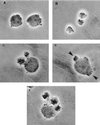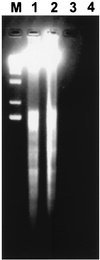Role of Mycoplasma penetrans endonuclease P40 as a potential pathogenic determinant
- PMID: 10456886
- PMCID: PMC96764
- DOI: 10.1128/IAI.67.9.4456-4462.1999
Role of Mycoplasma penetrans endonuclease P40 as a potential pathogenic determinant
Abstract
Recently, we reported the purification to homogeneity and characterization of Ca(2+)- and Mg(2+)-dependent endonuclease P40 produced by Mycoplasma penetrans (M. Bendjennat, A. Blanchard, M. Loutfi, L. Montagnier, and E. Bahraoui, J. Bacteriol. 179; 2210-2220, 1997), a mycoplasma which was isolated for the first time from the urine of human immunodeficiency virus-infected patients. To evaluate how this nuclease could interact with host cells, we tested its effect on CEM and Molt-4 lymphocytic cell lines and on peripheral blood mononuclear cells. We observed that 10(-7) to 10(-9) M P40 is able to mediate a cytotoxic effect. We found that 100% of cells were killed after 24 h of incubation with 10(-7) M P40 while only 40% cytotoxicity was obtained after 72 h of incubation with 10(-9) M P40. Phase-contrast microscopy observations of P40-treated cells revealed morphological changes, including pronounced blebbing of the plasma membrane and cytoplasmic shrinkage characteristic of programmed cell death, which is in agreement with the internucleosomal fragmentation of P40-treated cell DNA as shown by agarose gel electrophoresis. We showed that (125)I-radiolabeled or fluorescein isothiocyanate-labeled P40 was able to bind specifically in a dose-dependent manner to the cell membrane of CEM cells, which suggested that the cytotoxicity of P40 endonuclease was mediated by its interaction with the cell surface receptor(s). The concentration of unlabeled P40 required to inhibit by 50% the formation of (125)I-P40-CEM complexes was about 3 x 10(-9) M, indicating a high-affinity interaction. Both P40 interaction and cytotoxicity are Ca(2+) dependent. Our results suggest that the cytotoxicity of M. penetrans observed in vitro is mediated at least partially by secreted P40, which, after interaction with host cells, can induce an apoptosis-like death. These results strongly suggest a major role of mycoplasmal nucleases as potential pathogenic determinants.
Figures







References
-
- Alnemri E S, Litwack G. Glucocorticoid-induced lymphocytolysis is not mediated by an induced endonuclease. J Biol Chem. 1989;264:4104–4111. - PubMed
-
- Andreev J, Borovsky Z, Rosenshine I, Rottem S. Invasion of HeLa cells by Mycoplasma penetrans and the induction of tyrosine phosphorylation of a 145 kDa host cell protein. FEMS Microbiol Lett. 1995;132:189–194. - PubMed
-
- Benedik M J, Strych U. Serratia marcescens and its extracellular nuclease. FEMS Microbiol Lett. 1998;165:1–13. - PubMed
-
- Blanchard A, Montagnier L. Aids-associated mycoplasmas. Annu Rev Microbiol. 1994;48:687–712. - PubMed
Publication types
MeSH terms
Substances
LinkOut - more resources
Full Text Sources
Miscellaneous

